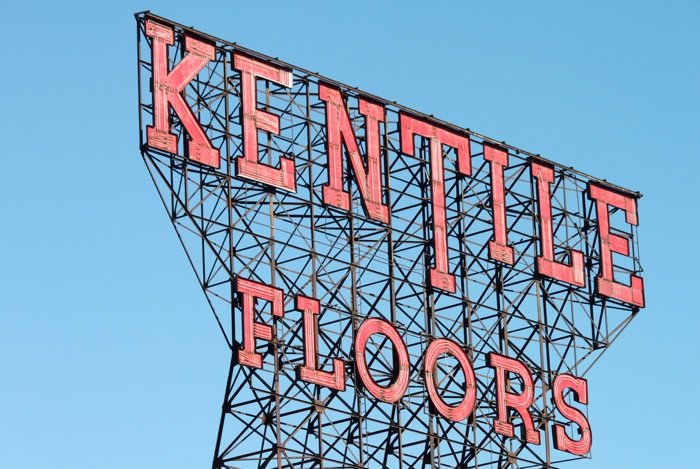Confirmed: Kentile Sign to Be Removed, But Saved -- Hopefully
The Kentile sign is coming down, the owner of the building confirmed via statement to The New York Times, because the roof under it and the sign need costly repairs. Councilman Brad Lander met with the owner and helped broker a deal to save it. There have been protests against its removal and the building’s…


The Kentile sign is coming down, the owner of the building confirmed via statement to The New York Times, because the roof under it and the sign need costly repairs. Councilman Brad Lander met with the owner and helped broker a deal to save it. There have been protests against its removal and the building’s owner is sorry to see it go, said the story.
“We love the sign, and we heard the voices of so many community members. We will work hard to preserve the letters during removal,” said the owner in a statement to the Times. But it needs costly repairs, said the Times:
On Tuesday, Mr. Lander said, he met with Mr. Cohen, who explained that the sign’s steel structure was rusting and crumbling and needed to be scraped and repainted. The building beneath the sign was itself damaged by Hurricane Sandy, and needed work, Mr. Lander said Mr. Cohen told him. Mr. Lander said Mr. Cohen told him that doing all the work needed to preserve the sign would be too costly to be worthwhile.
The Gowanus Alliance is working to save the sign and find a new home for it. However, there is danger the letters could be damaged as they are moved. Lander said he hopes to arrange for their descent via pulley rather than cramming them down a small chute, as the demo permit specifies.
Kentile Sign Will Be Dismantled, With New Home in Mind [NY Times]
Photo by Joseph





So, the same organization that was responsible for killing the Gowanus historic designation is being entrusted to preserve the sign for potential use at a future date.
The preserved letters would look hip on the exposed brick wall of my kitchen, but “Kentile Floors” would give way to more appropriate culinary anagrams such as: “Loneliest Fork,” “Fillet Snooker,” or “Fee Oink Stroll.”
I can leave the curtains open so the sign’s acolytes can enjoy it in its new incarnation.
Why is Brad Lander working so hard to save a sign (which I love too, but still, it is just a sign), yet doing nothing about the demolition of a huge chunk of the Center Slope (16 historic buildings with 103 units of affordable housing), that Methodist Hospital is proposing? I am personally much more concerned about the fact that Methodist says it is going to build a 500,000 foot large, 150 foot tall building with an entrance on residential 8th Avenue. Hundreds of thousands more cars and thousands more trucks are going to be coming to Park Slope’s narrow streets each year. What is being done about that? And Methodist still has not explained what the need is (other than to look more like a Manhattan hospital). Most of the building is going to be used for services that Methodist already provides and will shift there from the Barnes and Noble building and the Hospital, plus some dr’s offices. Do we really need to destroy brownstones so Methodist can have a fancier building?
Well put KenTile! Not to mention that the brownstones being destroyed are some of the oldest in the neighborhood, circa 1895.
Lander was on WNYC this morning saying how responsible development needs to be defined by supporting infrastructure. So I ask Lander, where is the supporting infrastructure for this mammoth hospital building? It just can’t work in our narrow streeted, residential neighborhood.
are you kidding me?
hospitals ARE infrastructure for growing communities. park slope/brownstone brooklyn aren’t some living museum – they’re neighborhoods in a growing city. get real.
ps – i don’t care when those houses were built – they’re shitty looking – no great loss.
Once again Real Estate Money triumphs over citizen’s will. Take all the trees and put ’em in a tree museum; charge the people a dollar and a half just to see ’em.
LOLLLL
Before Methodist is allowed to raze 16 buildings and put up a tower in the middle of Park Slope, shouldn’t there be a study on how this really will impact all Brooklyn hospitals. There’s a good likelihood that Methodist’s success has been at the cost of other neighborhoods’ hospitals, and its expansion will leave those other hospitals in worse financial condition than they’re already in. Interfaith Hospital is a good example. The lion’s share of Methodist’s patient growth over the last decade comes from people who live closer to Interfaith than Methodist. Meanwhile, only 2% of Interfaith’s patients have private insurance, which is a big reason it went bankrupt. At Methodist, on the other hand, nearly 1/3 of patients are privately insured — one of the highest rates in the City. Is Methodist taking paying patients from other hospitals? Will its expansion only exacerbate that situation to the detriment of many of the already-financially shaky hospitals in Brooklyn? Do we want Methodist and Maimonides to be the only hospitals left in Brooklyn in 10 years? When DeBlasio was Public Advocate, he proposed creating a Brooklyn Hospital Authority to oversee all this and bring some equity and rationality to Brooklyn’s hospitals. I’d like to see that happen before Methodist tears down irreplaceable 19th Century buildings.